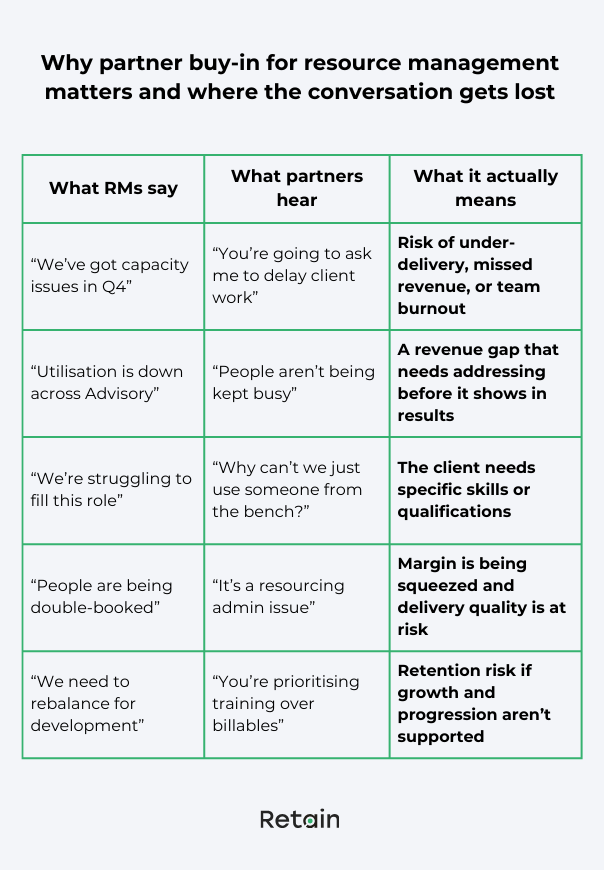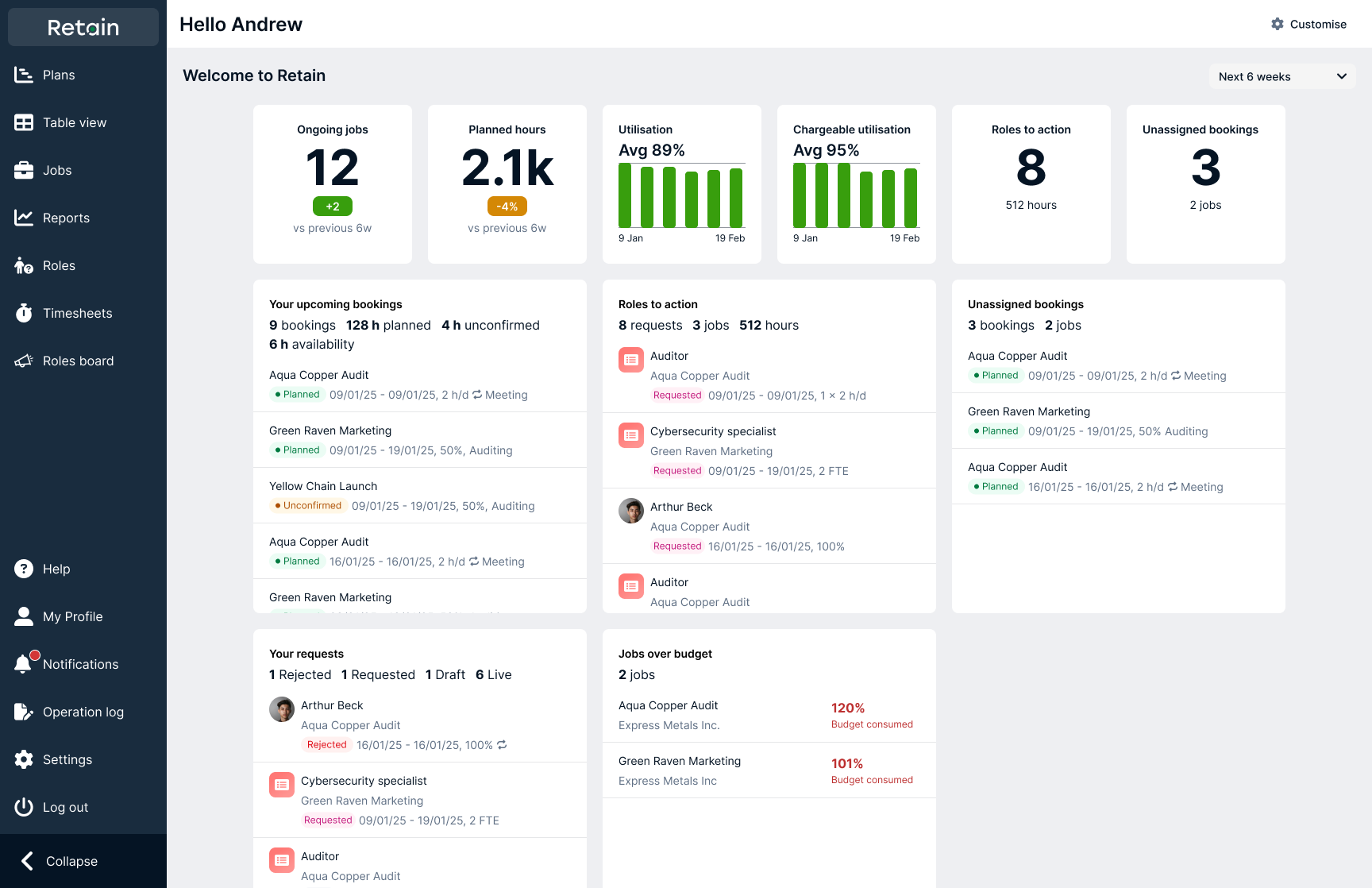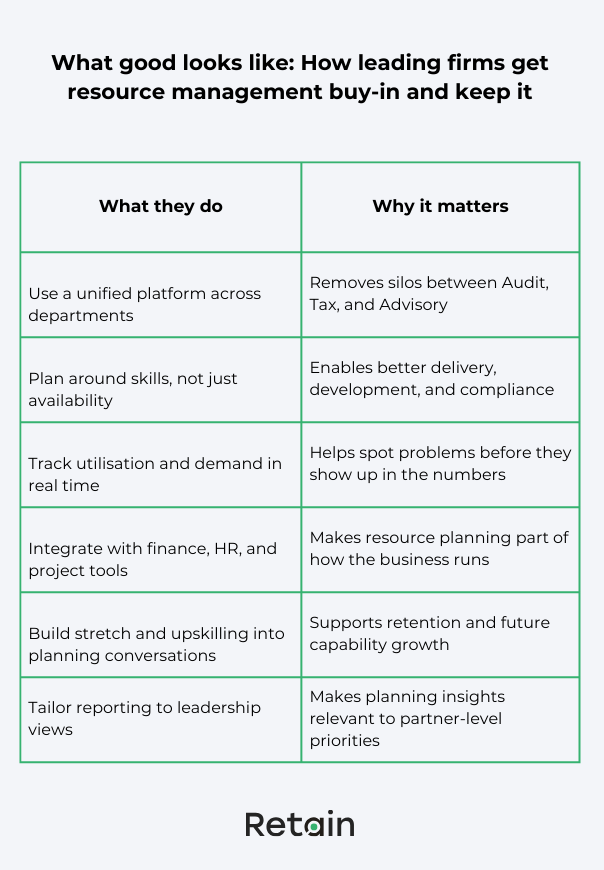Revenue growth across professional services has slowed to just 4.6%, the lowest in five years. At the same time, 57% of accounting professionals believe AI will have a major impact on the industry. With pressure building from both directions, firms need to make better decisions about how people are planned, developed, and deployed.
That can’t happen without partner support.
Resource planning often sits on the sidelines, seen as a scheduling exercise rather than a lever for growth, delivery, or compliance. But when done properly, it’s exactly that. The challenge is helping senior stakeholders see the value.
This post looks at how to do that. How to make resource planning real and relevant to partners. And how to turn operational insight into something they’ll care about.
Why partner buy-in matters

Most resource managers don’t need convincing that planning is critical. The challenge is getting partners to see it the same way.
Too often, resource management is treated as an operational layer. They see it as something separate from client delivery, commercial performance, or strategic planning. It’s rarely discussed in board meetings. And when it is, the conversation tends to focus on availability, not capability.
This is where the conversation gets lost:

That disconnect matters because the things partners care about, like revenue, risk, and reputation, are directly impacted by how resources are managed. A poor match can damage delivery. A missing certification can cause compliance issues. Underutilised teams hit the bottom line, and overworked people don’t stay.
The bottom line: Partners need to see how resource planning connects to the metrics they already track.
What partners want to see

If you want partners to care, you have to meet them where they are. That means shifting the conversation from headcount and availability to performance, risk, and return.
Start with the metrics they already track:
- Billable utilisation
- Project profitability
- Client delivery quality
- Regulatory compliance
Resource planning affects every one of them, but the link isn’t always made clear. For example, showing that a role is still unfilled doesn’t land. Showing that a key client project is at risk of going over budget, or being staffed with the wrong level of experience, does. Partners want to understand what’s at stake.
The same goes for planning around skills. Saying “we don’t have capacity” feels like a blocker. But showing that only two people in the firm are certified for a high-risk engagement (and both are overbooked) suddenly makes it a business risk.
This is where integrated systems matter. The more you can connect planning data to finance, project delivery, and compliance systems, the easier it is to surface these links. Project codes, in particular, are often the bridge. They tie time, cost, and resource allocation together, giving you the data to back up every staffing decision with real-world impact.
The bottom line? Stop trying to convince partners with resourcing logic. Show them the commercial consequences instead.
Make resource planning tangible

It’s one thing to say there’s a resourcing risk but another to show it; clearly, visually, and in context.
Dashboards are a big part of making resource planning land with partners. But they need to show the right things. They show who’s available or what’s unassigned, plus what that means in real terms:
- Are high-priority projects at risk due to skill gaps?
- Are key people being overused or misallocated?
- Are we about to fall short on compliance for a regulated role?
- Are we leaving margin on the table by underutilising specialists?
Retain Cloud, for instance, surfaces risk indicators like overbooked roles, unfilled high-stakes projects, or mismatches between skill level and client expectations. It also lets you drill down by department, region, or project type, so you can give partners exactly the view they need.
Even simple visuals can change the conversation. A summary screen showing the number of open roles by business unit. A graph mapping forecasted utilisation against pipeline. A flag next to a client project that’s short on qualified staff.
Position resource planning as a growth enabler

One of the main reasons partners don’t engage with resource planning is because it’s seen as admin. Necessary, but not strategic.
That perception only changes when planning is tied to outcomes that matter: revenue, retention, reputation, and risk.
Done properly, resource planning helps firms:
- Win and keep clients, by matching the right expertise to every project.
- Stay compliant, by ensuring qualifications and experience align with regulatory requirements.
- Retain top talent, by giving people work that stretches and develops them.
- Avoid burnout and bench time, by balancing workloads across teams.
- Plan for growth, by identifying where skills need to be developed before demand hits.
Partners don’t need to see the scheduling logic. They need to see what happens when it works and what it costs when it doesn’t.
As Kathleen Fitzgerald puts it:
“Resource planning is how firms prepare for the skills they’ll need next—not just the work on the desk today.”
That shift in framing is often what gets buy-in. Because it positions resource planning as a way to protect margin, reduce risk, and make the business more resilient.
Not admin. Advantage.
What good looks like: How leading firms get buy-in and keep it
Firms that succeed in securing partner buy-in tend to do a few things differently. In short, they frame resource planning as a firm-wide capability, not a standalone process.
Here’s what they get right:

This creates a consistent rhythm of visibility, communication, and decision-making, so that partners see resource planning as a way to protect what matters most.
And once they see that, they stay engaged.
Get resource planning buy-in
When you frame resource planning in the language of risk, revenue, and delivery, you give it the weight it deserves. When you connect planning tools to financial systems, client outcomes, and compliance requirements, you make it real. And when you show how better planning supports growth, resilience, and retention, you make it relevant.
That’s when partners start to listen. And that’s when resource management becomes something the whole business backs.
If you’re keen to learn more, we’d love to walk you through a live demo of a solution in action.


